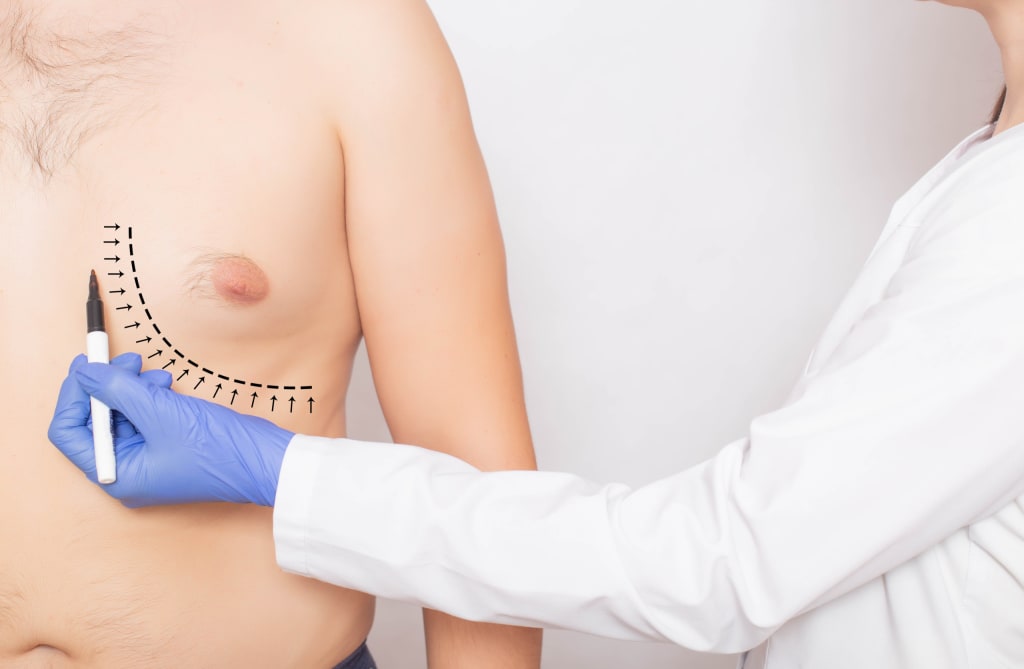Effective Treatment Methods For Gynecomastia
Restoring Confidence and Masculine Contour

Gynecomastia, often referred to as "man boobs," is a condition characterized by the enlargement of breast tissue in males. While it isn't typically a serious medical problem, it can cause significant emotional distress and affect self-esteem. This article explores the causes, treatment options, and psychological impact of gynecomastia, providing insights into how individuals affected by this condition can seek relief and regain confidence.
Causes of Gynecomastia
Gynecomastia can develop due to various factors:
Hormonal Imbalance: Fluctuations in testosterone and estrogen levels can lead to the growth of breast tissue in males.
Puberty: Hormonal changes during adolescence can temporarily cause gynecomastia, which often resolves on its own.
Medications: Certain medications, such as anabolic steroids, anti-androgens, and some antidepressants, can contribute to gynecomastia.
Health Conditions: Conditions like obesity, liver disease, and hormonal disorders (e.g., hypogonadism, hyperthyroidism) can increase the risk of developing gynecomastia.
Lifestyle Factors: Excessive alcohol consumption, use of recreational drugs, and anabolic steroid abuse can also play a role.
Psychological Impact
Gynecomastia can have significant psychological effects on affected individuals:
Body Image Concerns: Enlarged breasts can cause embarrassment, self-consciousness, and a negative body image, especially during activities such as swimming or changing clothes in public.
Social Anxiety: Fear of ridicule or teasing from peers can lead to social withdrawal and avoidance of social situations.
Impact on Mental Health: Persistent distress related to gynecomastia can contribute to anxiety, depression, and reduced quality of life.
Treatment Methods
Gynecomastia, characterized by the enlargement of male breast tissue, can significantly impact self-esteem and quality of life. Fortunately, several treatment options are available to address this condition, ranging from conservative approaches to surgical interventions. This article explores various treatment methods for gynecomastia, providing insights into their effectiveness, benefits, and considerations for individuals seeking to alleviate symptoms and restore a more masculine chest contour.
1. Observation and Lifestyle Modifications
For mild cases of gynecomastia, especially those related to puberty or temporary hormonal changes, a watchful waiting approach may be appropriate. In these instances, the condition may resolve on its own over time as hormone levels stabilize. Additionally, adopting healthy lifestyle habits such as maintaining a balanced diet, regular exercise, and avoiding substances known to contribute to gynecomastia (e.g., alcohol, recreational drugs, anabolic steroids) can help manage symptoms.
2. Medications
In cases where gynecomastia persists or is related to hormonal imbalances, medications may be prescribed:
Selective Estrogen Receptor Modulators (SERMs): Drugs like tamoxifen or raloxifene can block estrogen receptors in breast tissue, reducing the size of the breasts.
Aromatase Inhibitors: These medications inhibit the enzyme aromatase, which converts androgens into estrogen. Examples include anastrozole and letrozole, often used in the treatment of hormone-sensitive gynecomastia.
Medication therapy is typically considered for individuals who prefer non-surgical options or as a pre-operative measure to reduce breast size before surgical intervention.
3. Surgical Intervention: Gynecomastia Surgery
For individuals with persistent or severe gynecomastia, surgical intervention is often the most effective treatment option. Gynecomastia surgery, also known as male breast reduction surgery, aims to remove excess breast tissue and reshape the chest contour to achieve a more masculine appearance. There are several surgical techniques employed based on the amount of tissue to be removed and the desired outcome:
Liposuction: This technique involves using a thin tube (cannula) to suction out excess fat from the breast area. Liposuction is particularly effective for cases where gynecomastia is primarily due to excess fatty tissue.
Excision: In cases where glandular breast tissue or excess skin needs to be removed, surgical excision may be necessary. This technique allows for precise contouring of the chest to achieve a flatter and more natural appearance.
Gynecomastia surgery is typically performed under general anesthesia as an outpatient procedure. Recovery time varies but generally involves wearing a compression garment to minimize swelling and support the new chest contour. Most patients can resume normal activities within a few weeks post-surgery, with full results becoming apparent as swelling subsides.
Choosing the Right Treatment
The choice of surgical treatment for gynecomastia depends on several factors, including the severity of the condition, underlying causes, patient preferences, and overall health. Consulting with a qualified plastic surgeon specializing in gynecomastia treatment is essential.
Gynecomastia treatment methods range from conservative approaches to surgical interventions, each tailored to address the unique needs and preferences of individuals affected by this condition. Whether through observation, medications, or surgical correction, effective treatment can restore confidence, improve self-esteem, and enhance overall quality of life.
About the Creator
Nazmi Baycin
Dr. Nazmi Baycin is a board certified plastic surgeon. As the head plastic surgeon, he has performed more than 7000 surgeries. He specializes in all procedures within the field of plastic surgery in Dubai.
Enjoyed the story? Support the Creator.
Subscribe for free to receive all their stories in your feed. You could also pledge your support or give them a one-off tip, letting them know you appreciate their work.






Comments (1)
Comprehensive. Thanks for sharing.